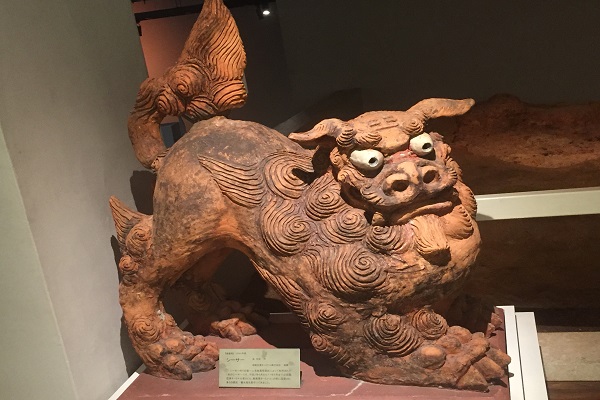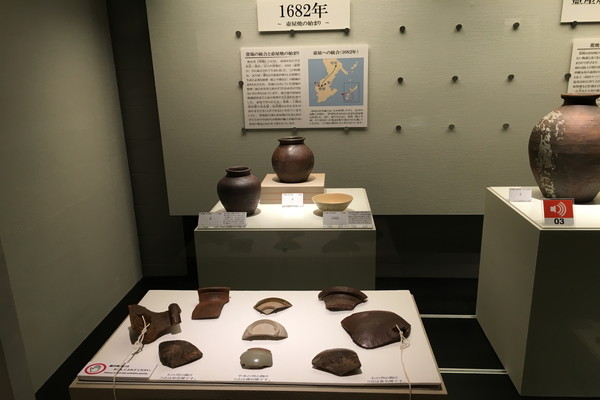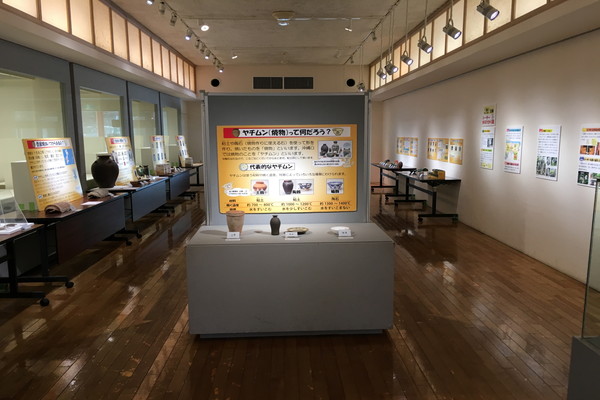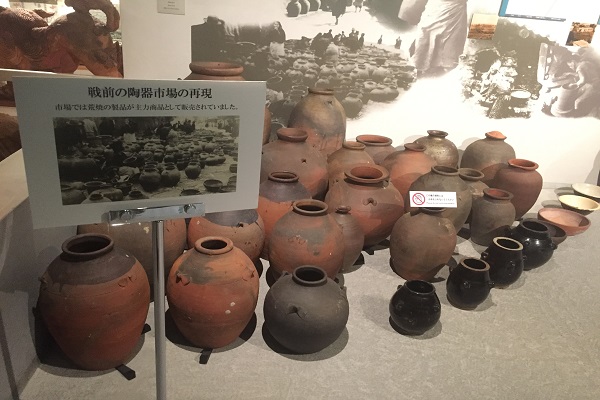Churaumi Aquarium is a popular tourist spot where you can see Whale sharks up close and personal.
-
Parking available
-
Wi-Fi available
The Tsuboya Pottery Museum is exhibiting historical Okinawan potteries. The site is an inaccessible place from Naha-city and free parking lot is available.
- CategoryTourism・History/Culture
- Phone number0988-62-3761
- AreaNaha/Shuri
- Parking5 parking lots
- TagMuseumShisaPotteryearthenwareNaha
- Hours10:00-18:00
Many Okinawan potteries are exhibited at the Naha-city Tsuboya pottery Museum on Yachimun alley Tsuboya Naha-city.
It was 6700 years ago when people started to make potteries on Okinawa. At the museum, you can see potteries exhibited by age and kinds. Normally you are not allowed to touch on these exhibitions at the museum, however, at the Naha Tsuboya museum, you can touch potteries. Here is the best spot for not only adults, but also for children to learn about Okinawan historical potteries.
Must-see sights
-

Shisa
Shisa was derived from China during the end of 15 century. At first, it was the symbol of power and authority, and for protecting people. People started to make Stone Shisas at their villages as guardian god and protection against fire. The oldest size still remains in Urasoe Yodore castle ruins. There are two big Shisas are exhibited on the 2nd floor. This size was set at the Naha-airport till May 1999.
-

Okinawa and Asian pottery
At the museum, you can also observe not only Okinawan but also Asian potteries. They are exhibited by ages, so you can learn about history of potteries and can actually touch them. There are many kinds of potteries. Some are rough, some are smooth. Feel free totouch them compare.
-

Exhibition show
The exhibition show on the 3rd floor is free of charge. The exhibition changes periodically, you can check the information on Naha-city Tsuboya pottery museum web page. The theme of the exhibitions is different, so even if it's not your first time visiting, you can enjoy!
A Little Tidbits of Naha-city Tsuboya pottery Museum

Naha-city Tsuboya pottery Museum is located in the Yachimun alley Naha-city. The museum is also close to Kokusai street, there are places to stay around the museum. Most of the tourists visit the museum when they have a little spare time.
At the entrance of the museum, you can see a piece of porcelain, stoneware, pottery, tile and clay ware are exhibited. You can compare them by touching.
There is a room called "Yuntaku corner" close to the reception desk. You can enter the room for free. You can stop by and have a little break. On here, documents of the potteries are exhibited, hence during the summer vacation season, many students come and work on their summer research assignment. The DVD about pottery is also shown. Feel free to ask one of the staff if you have any questions.
The 1st floor, the potteries of Okinawan and Asian countries are exhibited. You can observe the histories of potteries from during the age they were importing clay wares and potteries with interpretive panels.
6700 years ago, Okinawan people started to make potteries for the first time. Gusuku clay wares and tiles are exhibited at the museum. Moreover, there are colorful pottery, souvenirs made for American people after the war period. When you go further the 1st floor, the image video of potter working is also shown every 1 hour. The staff will ask you if you want to watch the video.
The Old Okinawan style house is also exhibited. You can see the potteries used in everyday life.
Many tourists from around the world visit the museum, hence if you show some ID, you can borrow the audio tour guide for free. There are Japanese, Okinawana dialect, English, Spanish. Chinese, and Korean audio tour guide is available.
The exhibition show on the 3rd floor is free of charge. The exhibition changes periodically, you can check the information on Naha-city Tsuboya pottery museum web page. The theme of the exhibitions is different, so even if it's not your first time visiting, you can enjoy!
On August 2017, the "Haisai Yachimun Discover Yachimun" was exhibited.
The pottery is made from clay or porcelain stone. In Okinawan dialect, the pottery is called "Yachimun". As the representative Yachimun, there are clayware, pottery and porcelain. They are categorized by the temperature of making and materials. You can learn about many various kinds of potteries and history of them at the museum. It's also the best spot for school students of studying for their summer research program.
At the museum, there are steps and elevators available. The staff at the reception desk is very friendly, if you have any questions feel free to ask them.
It's recommended to take a walk at the Yachimun alley after you enjoy the museum. There are many shops and Shisa making place on the street where you can enjoy shopping. There are some shops you can enjoy experience making the potteries. At "Ikutoen", for 2500-3000 yen, you can make Shisa, dish Shisa, potter's wheel, and painting. At the "Huki", you can make and paint Shisa for 1500-4800yen. For both need reservations in advance, It's recommended to make a reservation by a call.
(Ikutoen TEL:098-863-8611)(Shisa workshop Huki TEL:098-863-3283)
There are many good cafes at the Yachimun alley. It's recommended to visit "Nishinume", "Tsuboya alley","Higashi nuka","Bijurugua",Fenukama"and "Agarinukama" as well.
At the Tsuboya pottery center next to the museum, dishes and Shisa are selling. You can enjoy shopping at the center.
Pictures
Naha-city Tsuboya pottery Museum Information
| Name | Naha-city Tsuboya pottery Museum |
|---|---|
| Tel/Fax: |
TEL:0988-62-3761 TEL:0988-62-3762 |
| Address: |
Postcode:902-0065 1-9-32 Tsuboya Naha-city Okinawa |
| Access |
It takes about 20 minutes from Naha-airport by car It takes about 10 minutes from Makishi station by walking Bus: Get off at Tsuboya,Kainan,Tenbusu-mae bus stop. It takes 5 minutes by walking |
| Hours |
10:00-18:00 ※The last entry is by 17:30 |
| Closed |
Monday (Except holiday) |
Entrance fee
| Entrance fee |
General : 350 yen |
|---|
How to pay
| Budget |
280-350 yen |
|---|---|
| Optional fee |
0 |
| Credit card |
Not available |
| Currency |
JPY only |
| Reservation |
Not required |
Facilities
| Parking |
Free:5 parking lots There are coin-operated parking for 40 cars. |
|---|
Information
| Time |
60 minutes |
|---|---|
| Smorking |
Non-smorking |
| e.t.c |
Wi-fi spot, wheelchair, stroller rent is available, the museum welcomes the visitors with assistance dog. |
A little advise from Churashima travel
| A brief comment |
There are many Shisa and potteries at the museum. |
|---|---|
| Important notice |
Some exhibitions are not allowed to touch. |
| What to bring |
|































